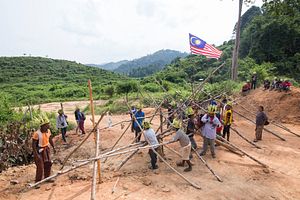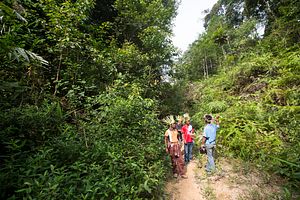In peninsular Malaysia there are 18 officially recognized indigenous tribes. The ancestors of these indigenous tribes were the first people to populate the peninsula more than 4,000 years ago. Since then, they have held to a hunter-gatherer and small scale agricultural lifestyle. The rapid development of Malaysia during the last few decades, intensive logging, expansion of palm oil plantations and other large scale agricultural crops have left indigenous tribes increasingly in a grey area, rendering them as one of the most vulnerable communities in Malaysia. Currently, most of the forests that they depend on for their livelihoods are owned by the Malaysian government; only a few areas are recognized as ancestral forests belonging to the indigenous tribes, and these areas were obtained through legal suits against local governments.
In Perak, a state in Northern Malaysia, the first records of indigenous people opposing logging on their ancestral lands date back to 1937. For more than 80 years, Malaysia’s indigenous tribes have tried to lay modern claim to lands their people have lived on for centuries.
In Perak, the Temiar tribe — one of the largest tribes in the northern part of the Malaysian peninsula — are fighting to obtain rights over 12,465 hectares which they claim as ancestral forests. Several Temiar villages this year erected blockades to prevent a logging company from accessing forests — part of the Air Cepam Forest Reserve in the Perak state — the local government has granted it permission to cut.
Two blockades were erected near Cunex village at the beginning of the year and near Ong Jangking village in April. Since then, the blockades have been torn down several times by the loggers and local authorities, several villagers were arrested, one court case has already been filed and another is in the preliminary stages of filing, by indigenous people against the local government. “Since we first built it, the logging company, sometimes along with local police and/or the local forestry department have torn down our blockade five times. We rebuild the blockade every time the night after they tear it down,” said Anjang, a villager from Ong Jangking village.
Ong Jangking is a small Temiar village located deep in the forest of Gerik, Perak. The 17 families living there have settled the current position of the village in 2018. The Temiars move around within their ancestral forests, living for a few years in one place at a time, as it has been for many generations. “If something happens – like a death in the village, or we don’t find enough resources around our village area, or the area is not safe anymore for us, we just move,” said Anjang.
Their shifting cultivation lifestyle, quite different from the modern, sedentary lifestyle of the vast majority of the Malaysian population, has put the Temiars in an even more vulnerable position. Traditionally, the Temiars create new settlements as needed, but those settlements are not recognized by the government. The government in turn has designated land for the indigenous tribes in certain areas, relocating whole villages in the process. In the Gerik area there is RPS Dala, where in the 1980s “villages of different tribes from all around Northern Perak area were relocated by the government in the idea of a safe place with better infrastructure and economic development for the indigenous tribes,” explains Dr. Colin Nicholas, founder and coordinator of the Center for Orang Asli Concerns, an NGO advocating for indigenous people’s rights in Malaysia.. “The land given to them in RPS Dala is small, the communities expanded over time and the infrastructure development didn’t happen, as some of the villages in RPS Dala still don’t have a safe source of water till today. So some of them went back to their original areas feeling that they could do better with their traditional lifestyle.”
At the heart of the conflict between the Malaysian government and the Orang Asli (the Malay term for the region’s indigenous people) are issues of land and ownership, and with those matters questions of life and livelihood. From the government’s point of view, all land except the areas specifically set aside for for Orang Asli settlements (like RPS Dala), belong to the government and can be used for the economic benefits of the state. “All logging permits issued are within the Forest Reserves in Perak, which do not involve any existing Orang Asli settlement. None of the land or area which are currently occupied by Orang Asli settlements had been encroached to make way for logging activity. In short, there is no incident of Orang Asli community being chased or displaced to make way for logging,”Ahmad Faizal Azumu, chief minister of Perak stated in an email.
The government doesn’t recognize some of the Orang Asli settlements located outside the areas designated for them, like Cunex or Ong Jangking villages, which are actually located within the forest reserve areas. “The Kampung [village] Cunex families are a splinter group of Kampung Orang Asli Sungai Sarok who live in RPS Dala (Dala Relocation Scheme). The 26 families had left the settlement in 2017 following a fallout with the village’s head and opened a new settlement in Air Cepam Forest Reserve area, about 5 kilometers away from RPS Dala. The group subsequently erected a blockade to prevent logging activity in Air Cepam Forest Reserve, which is not within their settlement area,” chief minister Azumu told The Diplomat.
Even after the relocation, the indigenous people were not legally bound to live exclusively on the lands set aside for them.“There is no law forbidding the Orang Asli to move around freely and start new settlements, but the government is expecting them to live in the land that was gazetted for them. In fact, they have been going back frequently after the relocation to gather fruits and hunt, they didn’t abandon their old places,” explained Nicholas.
After several months of guarding their blockade, the Temiars from the Cunex village filed a court case against the government. “The Kampung [village] Cunex people are claiming an area of Air Cepam Forest Reserve (gazetted in 1992 as a forest reserve) and Piah Forest Reserve (gazetted in 1915). They claim they were there even before government gazetted these areas as forest reserves. They are having a semi nomadic culture, they move from a place to another once in a few years. Originally they were living in Kampung Keleb, located 4 km away from the current location of Cunex, they were there around 1970. For safety reasons they moved to Kampung Agam in 1977. After that they moved to RPS Dala during the relocation time. After that they moved to the current Cunex. So they were there before the land was gazetted, they still had control over the land,” explained Thiyagu Ganesan, a lawyer representing the Cunex villagers in court.
People from from five nearby Temiar villages participated every day for months in guarding the two blockades. “Before the blockade we used to go to the forest every morning and harvest rubber, work in our gardens, look for forest vegetables and fruit or hunt for animals, but now every day from 8 a.m. to 4 p.m. we are at the blockade,”said Ayie, a 30-year-old villager from Ong Jangking. The Cunex blockade ended when the respective court case was filed on June 3, 2019. The Ong Jangking blockade stopped on August 1 when the local government issued a statement for a temporary halt to logging activities in both areas to allow discussions between the government and the indigenous people. “At this point the state government has freezed all logging activities in the area concerned. This is to make way for the state government to engage the Orang Asli communities and find acceptable solutions to everyone involved. Both the state and the Federal governments are committed to achieving a fair and just solution to protect the interests of the Orang Asli community in that area,” said chief minister Azumu.
The Temiars have thoroughly documented their struggle to keep the loggers out. Johari, 26 years old, sat daily on the blockade holding a DSLR camera, waiting for something to happen. The village’s media, he inadvertently became the story on July 23 when local police arrested him. “I was arrested because I was taking photos. The police came along with the loggers, and I had evidence of everything that happened when they tore down our blockade and images of the people who did it,” said Johari. “As I was being arrested, the police took my camera. Two of my friends asked them to give back the camera. The officer replied that if they don’t shut up they will also be arrested, so my friends surrendered without protesting. They also wanted me not to go alone so they came along. All in all the police took my camera, a memory card, two phones. All our things are still there, at the police station. After they went through our stuff, they asked us who is the head of the village, who taught us how to make a blockade, but it’s not like that, we all made the blockade together, nobody taught us.” Johari and his friends, arrested by the police for wrongful restraint — impeding travel along the road with the blockade. They were remanded in custody for two days by the Magistrate’s Court in Gerik before being released.
“We were never asked if we agree with the logging on our territory. Before we made the blockade we tried talking to all the authorities in charge but we got no answers,” said Anjang. “There have been cases before of indigenous people that won their rights to their ancestral land, even in Perak. I feel the only solution is to fight them in court.”
Several environmental NGOs in Malaysia, stand with the indigenous tribes, warning about the impact of logging in the few areas that have not been clear cut and transformed into agricultural lands. “The major threats of logging activities include the impact on the environment, loss of habitat and biodiversity, implications on climate change,” said Shariffa Sabrina Syed, president of PEKA, an environmental NGO. Recently, the Royal Belum State Park, neighboring the Air Cepam Forest Reserve, has been scheduled for evaluation by UNESCO in October 2019 in order to be included in the UNESCO World Heritage List for its biodiversity and uniqueness.
“We can observe that the remaining forests in Malaysia today are the ones where the Orang Asli live, which proves that they have been preserving the forests all along. It’s not that they are not using the forest, they are, but in a very sustainable way,” said Nicholas from COAC.
Alexandra Radu is a photojournalist based in Kuala Lumpur. Her portfolio is available here.

















































